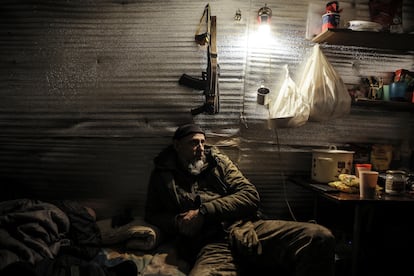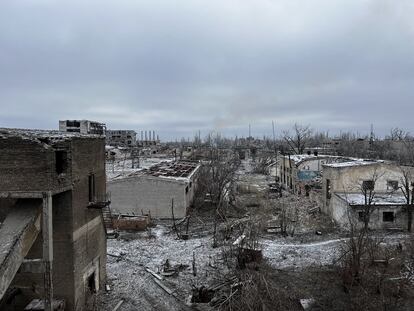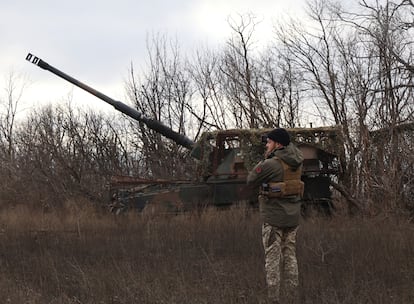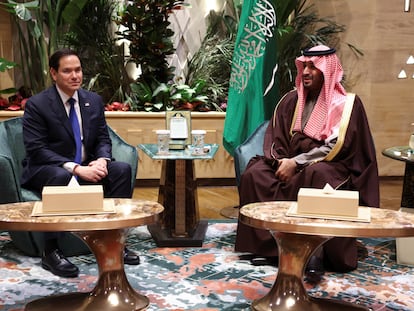Ukrainian troops in Chasiv Yar respond to Trump: ‘Russia does not want peace, it wants to destroy us’
Russia aims to conquer the besieged city in Donetsk in the coming weeks, key to expanding the Kremlin’s dominance in the eastern region of Donbas


The siren calls of Donald Trump and Vladimir Putin are ringing in the world’s chancelleries, but in Kostiantynivka only the sound of artillery cannonades can be heard. Peace must be achieved at all costs, the U.S. president has said, while the Russian invasion continues and the pain is felt, above all, in the few towns in Donetsk province still under the control of free Ukraine. Seven kilometres (4.4 miles) from Kostiantynivka, Russian troops are stationed in neighbouring Chasiv Yar. “The Russians are lying, they don’t want peace, they want to destroy us,” says Jack, the code name of a young soldier from the 18th Brigade of the National Guard.
“Putin is lying,” Volodymyr Zelenskiy told Trump on Thursday when the Republican assured him that the Russian autocrat wants peace. The Ukrainian soldiers in Chasiv Yar — many exhausted from years of fighting and losing comrades along the way — want peace more than anyone, but none trust Moscow.
Reports of Putin-Trump talks are also being discussed among Ukrainian soldiers. Young people like Mario, an anti-tank specialist from the 24th Brigade, were hoping for a ceasefire in 2023, as the invading forces had suffered heavily, losing tens of thousands of men in the Battle of Bakhmut: “But that didn’t happen, and now I don’t see any signs on the front that they want to stop. I don’t think there is any need to talk to them about it either.”
Chasiv Yar no longer exists, Ukrainian soldiers fighting there tell El PAÍS, which visited the town a year ago during the early stages of the Russian siege. The invader’s artillery worked tirelessly to clear the way for ground troops, who would arrive a few months later. Conan, the code name of a commander of an assault platoon of the National Guard’s 18th Brigade, shows images taken with his cellphone of what remains of Chasiv Yar, of streets that this newspaper’s correspondent photographed a year earlier: practically nothing remains standing. Conan and his men fight door to door, sometimes separated from the enemy by a dozen meters: “This is a battle of basements, down to the last building.”

The Armed Forces of Ukraine maintain a presence in 20% of this former mining town, now a scene of destruction. “Chasiv Yar is extremely important because if they take it, they would have a direct route to Kostiantynivka, Druzhkivka and Kramatorsk. And we don’t hold much more in Donetsk [30% of the area]. Once they take the whole province, they have Dnipro waiting for them,” says Conan.
Conan reveals that they have spoken to their enemies, in block-to-block combat at Chasiv Yar: “My experience is that if the conflict is frozen, the Russians will come back to attack. So what would have been the point of all those deaths?”
What happens in Chasiv Yar will determine how far Russia’s destruction and conquest in Donetsk continues. This province and Luhansk are the regions that make up Donbas, a territory that has been under Russian influence since 2014 and which, like the Crimean peninsula, the Kremlin will hardly relinquish in hypothetical peace negotiations.
“Defend Chasiv Yar to the end”
There have been municipalities in Donetsk where the Commander-in-Chief of the Armed Forces of Ukraine, Oleksandr Syrskyi, has ordered the withdrawal of his troops to avoid heavy losses. This will not be the case in Chasiv Yar, where the siege has already lasted for almost a year due to the enormous Ukrainian resistance, and thanks to its elevated position on the terrain, which makes it a fortress.
“I can confirm that we will defend Chasiv Yar to the end, because from there there is a direct line to Kramatorsk, and from there to Pavlograd [a city in Dnipro province],” explains Ambros, a 52-year-old soldier with the 24th Mechanized Brigade.
The military men interviewed admit that it will be very difficult to stop the Russians at Chasiv Yar. The main problem, they say, is the enemy’s superiority in numbers. Conan estimates that for every Ukrainian fighter in Chasiv Yar there are 15 Russians.
Even someone like Ambros, wounded three times in the three years of war, cannot leave the service, even though his health advises against it: “Who will take over from me? There are not many others. And people with experience who can teach the recruits, even fewer.” Ambros has suffered a concussion; his hands often shake. In 2023, he was hit by a tank shell, which destroyed his diaphragm. Of the seven soldiers defending his position, only he survived.
War is knocking at the door of the Butik Khliba bakery in Kostiantynivka. Whereas two years ago the shop was full, today there are no more customers. If the owner spoke to journalists then, she no longer wants to. The nervous woman says that they will continue to run the business “as long as the situation allows.” Then they will have to start a new life as refugees, having lost everything. The town has been left with virtually no civilians, and four other residents refuse to answer questions. Three municipal employees who are on their way to the only supermarket still open in the town also do not want to talk, except when it is suggested to them on the fly that a ceasefire may be signed before the siege of Kostiantynivka begins. “The Russians did not come here to go home,” says one of them.
The mood of the local population is the same as EL PAÍS recorded in other municipalities in the months prior to their destruction, such as Bakhmut in 2022, or now in Pokrovsk, when three years will have passed since the invasion began.
“Everyone is watching Pokrovsk, but Chasiv Yar is equally or even more important,” says Andrii, deputy commander of a unit operating a Polish Krab howitzer in the 26th Artillery Brigade. The town of Pokrovsk is, along with Kramatorsk, the most important Ukrainian stronghold in Donetsk. In both places, the main objective of the artillery is to neutralize enemy drone pilots.

Andrii’s Krab struck a hideout of Russian unmanned vehicle operators 10 kilometers from Chasiv Yar on February 6. The weather was favorable for firing on that day because there was wind and low clouds that make it difficult for enemy surveillance drones to fly. Units interviewed in the combat zone said that each operation depends on weather conditions that are unfavorable to the use of drones. From the evacuation of wounded comrades to troop rotation, assaults or artillery fire, both sides act when drones cannot operate accurately.
Dovro, the code name for a battery commander in the 26th Brigade, estimates that Russian artillery has a superiority of three shells to Ukraine’s one. Conan counters that more important than artillery is maintaining Ukraine’s drone strength, which is what is allowing the defenders to slow Russia’s advance on the front. That is why Zelenskiy stressed last Saturday at the Munich Security Conference that Ukraine has produced 1.5 million drones thanks to cooperation with various European Union partners.
Ukraine must not let its guard down, Zelenskiy said in Munich, because Putin does not want peace. That is why Ambros is not leaving Chasiv Yar and why the recruitment patrols continued last Saturday in the nerve centers of cities like Kyiv, searching for men hiding from the call to arms. Whether citizens like it or not, Zelenskiy said, “the mobilization must continue, as one body, one country.”
Sign up for our weekly newsletter to get more English-language news coverage from EL PAÍS USA Edition
Tu suscripción se está usando en otro dispositivo
¿Quieres añadir otro usuario a tu suscripción?
Si continúas leyendo en este dispositivo, no se podrá leer en el otro.
FlechaTu suscripción se está usando en otro dispositivo y solo puedes acceder a EL PAÍS desde un dispositivo a la vez.
Si quieres compartir tu cuenta, cambia tu suscripción a la modalidad Premium, así podrás añadir otro usuario. Cada uno accederá con su propia cuenta de email, lo que os permitirá personalizar vuestra experiencia en EL PAÍS.
¿Tienes una suscripción de empresa? Accede aquí para contratar más cuentas.
En el caso de no saber quién está usando tu cuenta, te recomendamos cambiar tu contraseña aquí.
Si decides continuar compartiendo tu cuenta, este mensaje se mostrará en tu dispositivo y en el de la otra persona que está usando tu cuenta de forma indefinida, afectando a tu experiencia de lectura. Puedes consultar aquí los términos y condiciones de la suscripción digital.
More information
Archived In
Últimas noticias
Chris Martin, Taylor Swift, Elijah Wood and other famous wedding ‘crashers’
‘How does it feel to be a failure?’: Elizabeth Berkley’s journey from ‘Showgirls’ ridicule to vindication
The story of the Málaga virus: The code that haunted Google’s cybersecurity center director for 30 years
The impact of Ecuador’s mega-prison: A polluted river, cleared forests and military checkpoints
Most viewed
- The low-cost creative revolution: How technology is making art accessible to everyone
- Christian Louboutin: ‘Young people don’t want to be like their parents. And if their parents wear sneakers, they’re going to look for something else’
- All the effects of gentrification in one corner of Mexico’s Colonia Roma
- Liset Menéndez de la Prida, neuroscientist: ‘It’s not normal to constantly seek pleasure; it’s important to be bored, to be calm’
- December Social Security and SSI payments: Dates, double checks and the 2026 COLA increase









































